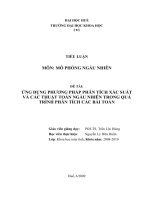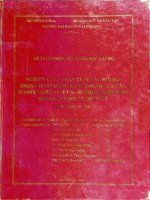Phân tích các bài đọc trong toeic 4 pps
Bạn đang xem bản rút gọn của tài liệu. Xem và tải ngay bản đầy đủ của tài liệu tại đây (48 KB, 6 trang )
35. Which of the following is NOT mentioned as a common element of theater
and ritual?
(A) Dance (B) Costumes
(C) Music (D) Magic
36. The word "considerable" in line 15 is closest in meaning to
(A) thoughtful
(B) substantial
(C) relational
(D) ceremonial
37. The word "enactment" in line 15 is closest in meaning to
(A) establishment
(B) performance
(C) authorization
(D) season
38. The word "they" in line 16 refers to
(A) mistakes
(B) costumes
(C) animals
(D) performers
39. According to the passage, what is the manin difference between ritual
and drama?
(A) Ritual uses music whereas drama does not.
(B) Ritual is shorter than drama.
(C) Ritual requires fewer performers than drama.
(D) Ritual has a religious purpose and drama does not.
40. The passage supports which of the following statements?
(A) No one really knows how the theater began.
(B) Myths are no longer represented dramatically.
(C) Storytelling is an important part of dance.
(D) Dramatic activities require the use of costumes.
41. Where in the passage does the author discuss the separation of the
stage and the audience?
(A) Lines 8-9
(B) Lines 12-14
(C) Lines 19-20
(D) Lines 22-24
Questions 42 - 50
Staggering tasks confronted the people of the United States, North and South, when
the Civil War ended. About a million and a half soldiers from both sides had to be
demobilized, readjusted to civilian life, and reabsorbed by the devastated economy.
Line Civil government also had to be put back on a peacetime basis and interference from
(5) the military had to be stopped.
The desperate plight of the South has eclipsed the fact that reconstruction had to be
undertaken also in the North, though less spectacularly. Industries had to adjust to
peacetime conditions; factories had to be retooled for civilian needs.
Financial problems loomed large in both the North and the South. The national debt
(10) had shot up from a modest $65 million in 1861, the year the war started, to nearly $3
billion in 1865, the year the war ended. This was a colossal sum for those days but one
that a prudent government could pay. At the same time, war taxes had to be reduced to
less burdensome levels.
Physical devastation caused by invading armies, chiefly in the South and border
(15) states, had to be repaired. This herculean task was ultimately completed, but with
discouraging slowness.
Other important questions needed answering. What would be the future of the four
million black people who were freed from slavery? On what basis were the Southern
states to be brought back into the Union?
(20) What of the Southern leaders, all of whom were liable to charges of treason? One
of these leaders, Jefferson Davis, president of the Southern Confederacy, was the
subject of an insulting popular Northern song, "Hang Jeff Davis from a Sour Apple
Tree," and even children sang it. Davis was temporarily chained in his prison cell
during the early days of his two-year imprisonment. But he and the other Southern
(25) leaders were finally released, partly because it was unlikely that a jury from Virginia, a
Southern Confederate state, would convict them. All the leaders were finally pardoned
by President Johnson in 1868 in an effort to help reconstruction efforts proceed with as
little bitterness as possible.
42. What does the passage mainly discuss?
(A) Wartime expenditures
(B) Problems facing the United States after the war
(C) Methods of repairing the damage caused by the war
(D) The results of government efforts to revive the economy
43. The word " Staggering" inline 1 is closest in meaning to
(A) specialized
(B) confusing
(C) various
(D) overwhelming
44. The word "devastated" in line 3 is closest in meaning to
(A) developing
(B) ruined
(C) complicated
(D) fragile
45. According to the passage, which of the following statements about the
damage in the South is correct?
(A) It was worse than in the North.
(B) The cost was less than expected.
(C) It was centered in the border states.
(D) It was remedied rather quickly.
46. The passage refers to all of the following as necessary steps following
the Civil War EXCEPT
(A) helping soldiers readjust
(B) restructuring industry
(C) returning government to normal
(D) increasing taxes
47. The word "task" in line 15 refers to
(A) raising the tax level
(B) sensible financial choices
(C) wise decisions about former slaves
(D) reconstructions of damaged areas
48. Why does the author mention a popular song in lines 22-23?
(A) To give an example of a Northern attitude towards the South
(B) To illustrate the Northern love of music
(C) To emphasize the cultural differences between the North and South
(D) To compare the Northern and Southern presidents
49. The word "them" in line 26 refers to
(A) charges
(B) leaders
(C) days
(D) irons
50. Which of the following can be inferred from the phrase " it was unlikely
that a jury from Virginia, a Southern Confederate state, would convict
them"(lines 25-26)?
(A) Virginians felt betrayed by Jefferson Davis.
(B) A popular song insulted Virginia.
(C) Virginians were loyal to their leaders.
(D) All of the Virginia military leaders had been put in chains.
Test 7
Questions 1-10
In science, a theory is a reasonable explanation of observed events that are related.
A theory often involves an imaginary model that helps scientists picture the way an
observed event could be produced. A good example of this is found in the kinetic
Line molecular theory, in which gases are pictured as being made up of many small particles
(5) that are in constant motion.
A useful theory, in addition to explaining past observation, helps to predict events
that have not as yet been observed. After a theory has been publicized, scientists design
experiments to test the theory. If observations confirm the scientists' predictions, the
theory is supported. If observations do not confirm the predictions, the scientists must
(10) search further. There may be a fault in the experiment, or the theory may have to be
revised or rejected.
Science involves imagination and creative thinking as will as collecting information
and performing experiments. Facts by themselves are not science. As the
mathematician
Jules Henri Poincare said: "Science is built with facts just as a house is built with
(15) bricks, but a collection of facts cannot be called science any more than a pile of bricks
can be called a house."
Most scientists start an investigation by finding out what other scientists have
learned about a particular problem. After known facts have been gathered, the scientist
comes to the part of the investigation that requires considerable imagination. Possible
(20) solutions to the problem are formulated. These possible solutions are called hypotheses.
In a way, any hypothesis is a leap into the unknown. It extends the scientist's
thinking beyond the known facts. The scientist plans experiments, performs
calculations,
and makes observations to test hypotheses. For without hypotheses, further
investigation
lacks purpose and direction. When hypotheses are confirmed, they are incorporated
into theories,
1. Which of the following is the main subject of the passage?
(A) The importance of models in scientific theories
(B) The place of theory and hypothesis in scientific investigation
(C) The sorts of facts that scientists find most interesting
(D) The ways that scientists perform different types of experiments
2. The word "related" in line 1 is closest in meaning to
(A) connected
(B) described
(C) completed
(D) identified
3. The word "this" in line 3 refers to
(A) a good example
(B) an imaginary model
(C) the kinetic molecular theory
(D) an observed event
4. According to the second paragraph, a useful theory is one that helps
scientists to
(A) find errors in past experiments
(B) make predictions
(C) observe events
(D) publicize new findings
5. The word "supported" in line 9 is closest in meaning to
(A) finished (B) adjusted
(C) investigated (D) upheld
6. Bricks are mentioned in lines 14-16 to indicate how
(A) mathematicians approach science
(B) building a house is like performing experiments
(C) science is more than a collection of facts
(D) scientific experiments have led to improved technology
7. In the fourth paragraph, the author implies that imagination is most
important to scientists when they
(A) evaluate previous work on a problem
(B) formulate possible solutions to a problem
(C) gather know facts
(D) close an investigation
8. In line 21, the author refers to a hypothesis as "a leap into the unknown
in order to show that hypotheses
(A) are sometimes ill-conceived
(B) can lead to dangerous results
(C) go beyond available facts
(D) require effort to formulate
9. In the last paragraph, what does the author imply is a major function of
hypotheses ?
(A) Sifting through known facts
(B) Communicating a scientist's thoughts to others
(C) Providing direction for scientific research
(D) Linking together different theories
10. Which of the following statements is supported by the passage?
(A) Theories are simply imaginary models of past events.
(B) It is better to revise a hypothesis than to reject it.
(C) A scientist's most difficult task is testing hypotheses.
(D) A good scientist needs to be creative
Questions 11-21
By the mid-nineteenth century, the term "icebox" had entered the American
language, but ice was still only beginning to affect the diet of ordinary citizens in the
United States. The ice trade grew with the growth of cities. Ice was used in hotels,
Line taverns, and hospitals, and by some forward-looking city dealers in fresh meat, fresh
(5) fish, and butter. After the Civil War(1861-1865), as ice was used to refrigerate freight
cars, it also came into household use. Even before 1880, half the ice sold in New York,
Philadelphia, and Baltimore, and one-third of that sold in Boston and Chicago, went to
families for their own use. This had become possible because a new household
convenience, the icebox, a precursor of the modern refrigerator, had been invented.
(10) Making an efficient ice box was not as easy as we might now suppose. In the early
nineteenth century, the knowledge of the physics of heat, which was essential to a
science of refrigeration, was rudimentary. The commonsense notion that the best
icebox was one that prevented the ice from melting was of course mistaken, for it was
the melting of the ice that performed the cooling. Nevertheless, early efforts to
(15) economize ice included wrapping the ice in blankets, which kept the ice from doing its
job. Not until near the end of the nineteenth century did inventors achieve the delicate
balance of insulation and circulation needed for an efficient icebox.
But as early as 1803, an ingenious Maryland farmer, Thomas Moore, had been on
the right track. He owned a farm about twenty miles outside the city of Washington, for
(20) which the village of Georgetown was the market center. When he used an icebox of his
own design to transport his butter to market, he found that customers would pass up the
rapidly melting stuff in the tubs of his competitors to pay a premium price for his
butter, still fresh and hard in neat, one-pound bricks. One advantage of his icebox,
Moore explained, was that farmers would no longer have to travel to market at night in
(25) order to keep their produce cool.
11. What does the passage mainly discuss?
(A) The influence of ice on the diet
(B) The development of refrigeration
(C) The transportation of goods to market
(D) Sources of ice in the nineteenth century
12. According to the passage, when did the word "icebox" become part of
the language of the United States?
(A) In 1803
(B) Sometime before 1850
(C) During the Civil War
(D) Near the end of the nineteenth century









